#basic Cut Nib Calligraphy course
Explore tagged Tumblr posts
Text
Forget the traditional dip-pens and ink! For, Brush Calligraphy by Penkraft is here! While similar in concept to the traditional calligraphy done using a cut-nib calligraphy dip-pen and ink, brush calligraphy differs in the tool being used for writing - a 'brush-pen' or even conventional brushes (the ones you use for water colours) - they are cheaper and easier to get used to! The basic rules stay the same - such as having thick down strokes and thin upstrokes, brush pens, due to their flexible nylon fibre tips are very easy to use - even with the first strokes that you make, you will immediately realize how different strokes are created based on the pressure that you apply on them. Also, brush pens are ready to use straight out of the box and they are in most cases quite affordable compared to traditional calligraphy dip pen sets. In this course, you shall learn, starting with the basic principles, strokes, and then moving on to the types of fonts and how to make your own compositions. As you finish one module and upload the associated assignment, the next module unlocks for you. So, unleash your creativity and have fun!
1 note
·
View note
Text
Calligraphy: The unique art of writing

Calligraphy is thought to be one of the most seasoned types of writing in the world. It is believed that the first of the Persian written work began as right on time as 500 or 600 BC. This was utilized on the engravings on the monuments of the kings. Among the numerous calligraphers who were celebrated were Kalhor and Mir-Emad. Calligraphy is utilized today as an artistic expression and has turned into a leisure activity for people everywhere throughout the world. Seek the accompanying assets for more data on finding out about this remarkable craft of writing.
Whether it is wedding or occasion solicitations, text style plan or typography, unique hand-lettered logo outline, religious art, declarations, graphic design or a charged calligraphic art, cut stone engravings, or memorial documents….all are a case of the thriving specialty of Calligraphy!
Calligraphy is additionally utilized for props and moving pictures for film and TV, tributes, birth and passing endorsements, maps, and other written works.
At Penkraft, we show you Calligraphy not just a strategy, but rather from the heart — utilizing the simplest equipment… be it a pencil, a fountain pen, a calligraphy nib, a charcoal piece or whatever other protest of day by day use around the house…any and each one of these is amiable to making a beautiful calligraphic example! We encourage your creative ability and test your inventiveness! In this modern calligraphy workshop, you will get the hang of everything about how to begin with idiosyncratic manually written lettering styles. Also, you will figure out how to write with a conventional fountain pen, utilizing lightness and pressure to make excellent thin and thick strokes. We will cover pen “pressure and release” methods along with the basics of illustrating letters.
Besides, you will be introduced with various inks, pens and papers, and in addition consider how to pick the best materials for your own work. This is a useful, casual class and the attention will be on having a great time while learning. We additionally show you to look after your instruments and how to clean and maintain them.
Penkraft conducts classes, course, online courses, live courses, workshops, teachers’ training & online teachers’ training in Handwriting Improvement, Calligraphy, Abacus Maths, Vedic Maths, Phonics and various Craft & Artforms — Madhubani, Mandala, Warli, Gond, Lippan Art, Kalighat, Kalamkari, Pichwai, Cheriyal, Kerala Mural, Pattachitra, Tanjore Painting, One Stroke Painting, Decoupage, Image Transfer, Resin Art, Fluid Art, Alcohol Ink Art, Pop Art, Knife Painting, Scandinavian Art, Water Colors, Coffee Painting, Pencil Shading, Resin Art Advanced etc. at pan-India locations. With our mission to inspire, educate, empower & uplift people through our endeavours, we have trained & operationally supported (and continue to support) 1500+ home-makers to become Penkraft Certified Teachers? in various disciplines.
0 notes
Text
#Cut Nib Calligraphy#Cut Nib Calligraphy course#certified Cut Nib Calligraphy course#Cut Nib Calligraphy writing#penkraft Cut Nib Calligraphy online course#online Cut Nib Calligraphy course#learn Cut Nib Calligraphy online#online Cut Nib Calligraphy class#Cut Nib Calligraphy materials#Cut Nib Calligraphy online for womens#Cut Nib Calligraphy online for kids#lettering and modern Cut Nib Calligraphy#lettering Cut Nib Calligraphy#Cut Nib Calligraphy lessons online#cutnip pen Cut Nib Calligraphy#Cut Nib Calligraphy classes for adults#best online Cut Nib Calligraphy course#brush lettering class#best Cut Nib Calligraphy classes#basic Cut Nib Calligraphy course#pencil Cut Nib Calligraphy
0 notes
Photo

Penkraft Cut Nib Brush Calligraphy course is a 20-hours, structured, module-based, certified course to be completed in 25 days. The course is suitable for age 8 years and above, and for adults.
During the course, you will first learn about how to hold the tool, how to make thin and thick strokes with the tool, how to apply and release pressure technique for basic illustration. The course then guides students to create different types of fonts like Gothic, Italic and Roman- in uppercase and lowercase followed by words and sentences. After that, you learn different compositions, decorating of borders and fonts, making decorative pictures that can be used for greeting cards, invites, etc.
0 notes
Text
Comic Girls - Episode 02
Why do I let myself stare into the abyss. …Anyways, anime. Anime is a good distraction. It’s Comic Girls, episode 02! Here we GO!
-It’s a new day at the dorm. The landlady is handling a chat with Kaos’s editor, who seems to be getting pegged into the motherly role for our little pink moeblob. And she can confirm that everything’s going great between all the girls, they’re getting along wonderfully…
-As Koyume puts Kaos’s long hair up into some twin buns. So what’s the over-under on the whole damn dorm turning Kaos into their doll slash mascot? But, they’re going out on a trip today! And not alone either, they’ll have Ruki and Tsuba—
-TSUBASA HAS ARRIVED! FULL SERIOUS MODE ACHIEVED! FEEL HER MANLY CHUUNI CHARM, YE LESBIANS, AND TREMBLE!
-Ruki quietly pulls her idiot roommate back to make her put on normal clothes. But even normal clothes still have Koyume swept up in her manly chuuni charm.
-Opening! Yep there are those lilies. If anyone turns out to really be a bear, I called it now.
-So where’s the gang going? Into Shinjuku, into the city proper! Into the kind of place where the trains are packed and the crowds are thick! So thick that Kaos finds herself being swept up in the sea of people, unable to escape…! At least until Ruki starts hauling people together. Ruki and Tsubasa, and Kaos quickly realizes all that damn manly charm Tsubasa has.
-Sidenote, just so we’re clear, I’m not the only one who’s just calling her Kaos all the time. Everyone is. We have heard her real name all of once, and I’m not sure what it is without looking it up. She’s just Kaos, through and through.
-Anyways, where do they end up first? Well, Kaos wants to go to a big proper book store…And woooowwww, this is a big place. Also I’m about 80% sure the fictional books the girls call out, like Super Exciting Paradise and Pretty Highness, are shoujo-ai books at the least. But that’s not all they find…Tsubasa’s latest work, the very same series they were just assisting on a few days ago, is on the shelf! And with a popup ad and the cover displayed! Holy shit they’re in the presence of not just an impossible amount of manly charm, but a GOD.
-So Koyume has to buy, like, five copies. As does Kaos. Even though Tsubasa has multiple copies of every volume to be given away as gifts. But you’re not going full otaku, or full hard crush, unless you’re spending money you don’t have to feed the machine. But eventually, they have their things…
-So what’s the next step? To a super trendy cafe! Where Kaos freaks out because only super cool high school girls can go in there. One, none of them are cool. Two, you’re a high school girl. Three, chill. Also Ruki insisted on lunch because if she doesn’t, Tsubasa will burn through all of her blood sugar at the art supply store and get dizzy. Again. So shut up and eat your damn crepe.
-And when the crepes arrive, Kaos doesn’t know how to handle something so cute, in a place full of nothing but trendy cute sexy young women in tiny miniskirts…Until finally Koyume feeds her the dang crepe.
-Finally to the art supply store and the meat we came here for. Kaos is freaking out at the density of the place. But, first step for her is she wants a full set of things she’d need as an assistant to be able to help everyone else out on the fly. Necessities it is! Forward MARCH! And then Tsubasa sees something she wants and she’s just gone, lost in her own fan behavior. Enthusiastic Tsubasa is kind of adorable, by the way.
-Then she picks up a feathered quill pen and sure, it looks cool, but it just seems impractical…
-And then Koyume says she looks cool with it and Tsubasa immediately goes FULL SERIOUS. Four-Quill Dip Style! And now she’s going to buy them all! Plus a ton of ink and new dip pens, as Koyume keeps trying to imitate her…And Tsubasa tries to encourage her to find her own path, but Koyume is most firmly motivated by, well, being like her Tsubasa-sama. It’s all that manly charm.
-So, quick sidenote, let’s explain fancy pens! While the analog comic artist has a lot of different options, there are essentially three major camps worth discussing for doing ink lines. These can be summed up in tech pens, brush and fountain pens, and dip pens. Some of this might get covered in the episode itself, but I love talking about stupid shit, so.
-Tech pens, or technical pens, started life as engineer’s tools before artists found them; you might be familiar with the Sakura Micron line if you’re a fucking weeb like myself. These are noted for a small, semi-flexible tip that gives a very consistent line width, and of course have an internal ink reservoir. Their greatest asset, this consistency, is also their chief weakness: A 0.5 millimeter tech pen is basically always going to put out a 0.5 millimeter line no matter which way you turn it or press it. This is fine, even preferable for more basic linework, but if you want to do more complex stuff…
-Then you need to consider brush and fountain pens. These are very different tools, but I’ve bundled them together to talk about them since they carry some similar advantages and disadvantages. Both still use an internal ink reservoir, though whether it’s pre-installed in a disposable or can be refilled varies. A brush pen uses an actual, quite flexible brush tip of I waaaaannna say a firm foam material, but don’t quite me on that, while a fountain pen uses a metal nib against a ribbed feed. The chief advantage here is flexibility; because firmness and angle matter, you can vary line width from stroke to stroke, or even within the stroke, by controlling your pen. The downside, naturally, is that you have to provide that control. Getting a line to stay at that 0.5 millimeter width the tech pen offers so easily, can be real hard with a brush pen, and not that much easier with a fountain pen. You don’t have as much flex with the fountain pen, but the size and shape of the nib give you a lot of control over like shape: Slightly modified forms, with a sharp-cornered square tip, are standard for Western style calligraphy, to give you an idea of what you can do with one.
-Lastly, and most simply thanks to all the previous stuff, are dip pens and straight-up brushes! These ultimately feed into the same idea as the fountain pen and brush pen, with one key difference: No ink reservoir. You have to dip into ink each time for your lines. This carries some advantages and disadvantages of its own, but it mostly feeds into the idea of control. Dip pens require very little commitment to a single shape for very long, as well as letting you do things to effect through how much or little ink you allow to fill the feed. All of this goes even further with the brush, though I’m gonna level with you, I don’t know of any manga artists who just use a brush like they’re doing fuckin’ sumi-e. I’m sure they exist, but they’re not likely to be found in the Jump-ass battle manga I typically read.
-Oh, and as ever, don’t quote me on this stuff I’m not an expert support your local library okay BACK TO THE SHOW
-So Tsubasa’s showing how you can use an overfull dip pen to create a really cool blood splatter effect by literally splattering the ink across the page, which is a skill Koyume wouldn’t even need while doing shoujo manga…And then Kaos sees their art pieces, from Tsubasa’s stern manly elf boy to the adorable shoujo girl from Koyume that he’s protecting…Aaand the best she can do is one of her cute chibi little characters in a very rough rendition of a knight’s armor, cheering them on.
-So where else are they going? To the screen tone section! Ruki is all gushing about new flower designs, which she inevitably ends up buying a bunch of. Koyume is imagining using them for cute flowing dresses on her girls. Ruki is imagining using them for sexy underwear. …Well, Ruki will be able to keep using the same pack for a lot longer, then, at least.
-Another aside while we’re talking craft, what are screen tones? You may have heard of them in previous manga-making shows and books, but the idea is really quite simple! They’re literally a pattern printed onto a very thin translucent sheet with a modest adhesive backing. When working in analog, you can get complex patterns easily by cutting out the rough shape of whatever you’re filling out of a matching screen tone sheet, adhering it down over your work, then using an x-acto knife to gently trace over the actual line edges and peel off the stuff you don’t need. You can easily recognize screen tone use because they tend to stay in the midtones, and are very consistent, being mass-produced and printed. Their most common uses are for complex symbolic backgrounds, and clothing patterns, but there are plenty of more complex and elaborate uses various artists have come up with!
-Back to the show. Ruki finds some cool bubbly background tones that Koyume can use…While Tsubasa’s going for the super-contrasty black and white lightning at FULL INTENSITY. And Kaos is buying lots of grim dark spoopy shadows. As for Ruki herself…She needs lots of smooth coverage for all the nudity coming up in her next work. Which means bubbly splotches, as Kaos asks what they’re for, and oh god she can’t admit the truth to this tiny innocent fetus.
-And then Koyume finds the cool patterned masking tape! …It’s patterned masking tape. Washi tape. If anyone you know goes to a craft store regularly or has a Pinterest account, you have seen this stuff. Tape in general is useful for keeping things firmly in place while working on your manuscript in an analog world, and, well, the cute patterns are because they are all teenaged girls. Mostly, Ruki ends up despairing when they start trying to pick sexy patterns for her, not some cute bubbly thing like everyone else got. I’m sorry, Ruki, but you have a reputation now.
-Also Tsubasa hears some girls debating pens and goes over to be all Cool and Manly and Get Their Numbers. …Okay mostly she goes over to offer help from a position of experience but I’m not wrong. So soon she leads them to some useful supplies for starting off drawing manga, and they’re all swept up in Tsubasa’s manly charm and Ruki’s gentle guidance and see themselves in Koyume and you can grow up to draw manga someday too, little pink haired moeblob!
-I’m sorry, Kaos.
-I mean, fuck, what else do you say to that, right?
-Eventually they can actually buy their stuff…Well, Koyume can buy most of her stuff. She’s a little shy after the books and the crepe. She’s gonna have to get rid of all of this cute masking tape…
-So Tsubasa picks it up to buy instead. And Kaos’s, too. A gift for both of you as thanks for the help the other day. Both girls are even more smitten than before. I didn’t think that was possible, but here we are.
-By the time they’re on the way back, it’s late in the day, and Kaos feels motivated to push even harder…Aaaand then they end up using the entire night chatting, and it’s time to get a few hours of sleep in the grim morning…
-When Tsubasa turns the TV on and the morning news is talking about the end of Golden Week.
-They have school.
-In like an hour.
-FUCK
-Episode 02: “Back to School”
-And Kaos gets to try on her new high school uniform, and she feels like she’s a real manga protag—
-And then she sees Ruki in her perfect setup and Tsubasa with her gives-no-fucks jacket and she realizes she’s just a background character next to these cool stylish girls she wants to smooch. …Oh and Koyume does the fucking shoujo manga toast-mouth run.
-Okay, to actual school! Where…
-I should have expected this.
-Tsubasa is the prince of the school.
-ofcourse.gif
-Also that cool splatter pattern on her shirt? …She spilled ink on it and just let it dry. How do you do this? Anyways, Tsubasa is the cool prince, and Ruki is the unapproachable stylish onee…sama…People are totally starting to realize she does something sketchy. Ruki, this is gonna be a lot less bad if they know you draw naughty manga than if they think you’re going and playing hostess to creepy old men or something.
-Oh and it comes out that Ruki and Tsubasa are the same age as our rookies. I’m sorry, they’re not older and more mature, those are just stress lines from the grim reality of a working mangaka lifestyle. Also Koyume is totally enthralled by the sexy slightly-stern homeroom teacher! So enthralled she puts a bow on her. And Kaos just wants to be scolded by the beautiful teacher lady. Truly you are Ruki’s apprentice.
-And then it turns out that while Ruki and Tsubasa are in the same class as Kaos, Koyume is in a different class. Alas, poor Koyume, no stern beautiful teacher lady for you. And that’s when Kaos realizes she hasn’t used her real name in so long she’s doubting her ability to write and pronounce it. She’s been going by Kaos around everyone. Everywhere. And people are staring. Trendy beautiful high school girls are staring, at her, with doubt in their eyes. So this, isn’t, ideal…But she finally pulls herself together despite the nervousness. That kid’s a real mess.
-Especially when she realizes she brought her manga pen case and not her school pen case. So instead of mechanical pencils and ballpoint pens, it’s dip pens, fat black markers and a screen tone pressing tool. …Well shit. And then people notice and Kaos cracks like an egg. If I hadn’t wanted to get a shot of each character for an episode…And then girls start asking her getting-to-know-you questions, which include her hobbies.
-So what are Kaos’s non-manga-drawing hobbies? She ingests tons of otaku media full of cute waifus and collects their slightly ecchi bishoujo figurines. But that’s not something you can say out loud. And the questions keep coming and Kaos just straight up faints. Which means a trip to the nurse’s office…And Koyume coming to check on her, before being dragged off by her new normal friends to get lunch. She’s already gotten friends. Alas, poor Kaos.
-At least you’ve got your fellow weirdos. But, yeah, Kaos suffers from social anxiety. I know these feelings all too well, even if they got expressed rather differently due to my own circumstances. Also when Ruki offers to get her moved closer to them in class, and Kaos’s look of appreciation just breaks Ruki as she has to keep herself from doing things to this sweet innocent zygote. …It doesn’t work very well.
-But Tsubasa’s advice is also that you don’t need to worry nearly so much about actually talking to people, making tons of friends, as you do about observing them…Learning from them. And that really hits home for Kaos, who’s been struggling with how to portray Normal High School Girls…Oh and Tsubasa’s advice is rounded off with her big buff bad guy sketch she’s been working on the whole time. You’re absurd.
-At the end of the schoolday, Koyume immediately comes and clings to her sweet little Kaos…And also she’s immediately made friends and had chats with girls who have actual boyfriends. Tsubasa and Ruki quietly despair at their own lack of success in love. Just steal these two rookies into the night, it’ll be fine. Mostly fine. It’ll work out. The law will never catch you.
-So, back to the dorm? Back to the dorm. When they run into…A stray kitty! TAKE THE KITTY HOME DO IT NOW. I DEMAND IT. And Kaos gets all the kitties. Except for one scared little kitty in the distance, so nervous, even as it lets her pick it up…She knows this fear, you sweet precious creature! KEEP THE CAT.
-Credits!
She better keep that cat.
And hey, another huge log. I blame the amount of setup, and also the amount of time we spent talking about craft materials. Next time should be more room to loosen up since we can broaden out to scene-level recap more. In theory. We’ll see what happens in episode THREE of Comic Girls! Wait for it!
1 note
·
View note
Photo

Cut Nib Calligraphy Workshop Kit
Purchase Penkraft's Cut Nib Calligraphy Workshop Kit, start to learn the basic principles, strokes, and different types of fonts, borders, pictures and make your own compositions.
Material provided in the Course Kit:
1. Penkraft Textbook 2. Calligraphy pens
For more details please visit - Penkraft | DIY Art Kits | Order Now
#Cut Nib Calligraphy Workshop Kit#penkraft#penkraft diy#do it yourself art#art kits for kids#art#craft kits#art & craft#painting kit
0 notes
Text
How I Write Baybayin (Handwriting and Straight-cut Nib Calligraphy) Subtitle: This is a freaking long-ass post so be warned now
You can read the entirety of this post as is, or you can go straight to the calligraphy portion. It’s at the end of the post (sorry dunno how to link that portion here).
Writer’s Note: First and foremost, I will advise everyone who reads this somewhat master post that I am not an authority when it comes to how baybayin is written, as what you shall be reading is just based mostly on my own experiences on how the characters are written and comparing them with other writing systems that are based on syllables rather than individual letters, like the Japanese Kana and the Korean Hangul, among others. This is because baybayin are not technically letters (individualized, can’t stand alone, only comes either as vowel or consonant but not both, you get the picture), but rather are syllables (i.e. the consonants have free vowels with them lol) that form words.
Also, as far as I know regarding how the baybayin texts are originally written pre-Hispanic colonization era, some of the written texts in the Philippines (or at least, those that survived, or I remember seeing in old history books) were written from right to left, top to bottom. This also coincides with other writing methods in some parts of Asia that also read from right to left. The technique of writing and reading from left to right may be a Western invention, in my opinion so I just did some of the strokes in the baybayin characters go from right to left, except for the straight-cut nib section. Again, I am no authority so I’m just doing what I think makes sense to me, as there is no existing ANCIENT written rules on the stroke order of the baybayin. Other people may disagree with my stroke orders here due to various reasons, but if you’re into what I did then feel free to learn from them, for free. *heart*
This author’s other notes: I won’t be elaborating the history of baybayin here because that would take around (counts how many years I spent in school) 5ever as it basically intertwines with the “current” history of the Filipino people. I put quotes on “current” because every decade or so, some written histories get re-written based on some evidences or what, and I totally respect that. It’s like in scientific papers: legit today, debunked tomorrow. And it’s completely OK, because THE MORE YOU KNOW~
Also this author’s note: I keep calling baybayin alibata, because that’s what they were called when I was a kid and how it was taught by history teachers before the process called “being politically-correct” became the norm. It’s because alibata was supposedly an incorrect term which signifies that the characters were letters based on Arabic, but apparently it wasn’t so.. Yeah. I’m just saying, so the kiddies would know. And if you’re like me who also refers to baybayin as alibata, let’s get a high-five! (Cause you’re also old, but gold =D) Some biased history FTW lol ok let’s get started.
Handwriting Alibata Baybayin Strokes with a Bamboo pen (or Ballpen, or Pencil, w/e floats your boat)
OK, before I start I would be first putting here the somewhat traditional ordering of the baybayin, which is:
A BA KA DA E GA HA I LA MA NA NGA O PA RA SA TA U WA YA
As well as the borrowed/loan syllables (which correspond to C, F, J, Ñ, Q, V, X, and Z were apparently added some 6-7 years ago, in which I didn’t get the memo x__x)
CA FA JA ÑA QA VA XA ZA
OK, now that’s out of the way, it’s time for the actual stuff. For ease of practice and recall, I’m grouping the letters based on how I write them and in turn, their forms. This would make sense as the pictures move along, don’t worry. The forms are built sequentially, I tried making that a bit obvious in the diagrams, but there are red arrows in case I wasn’t that clear. For those that only have one picture or arrows in the sequence, I would be implying that the form is built on a single stroke.
Group 1: A, MA, PA, YA, FA, JA, VA
OK, let’s start with A:
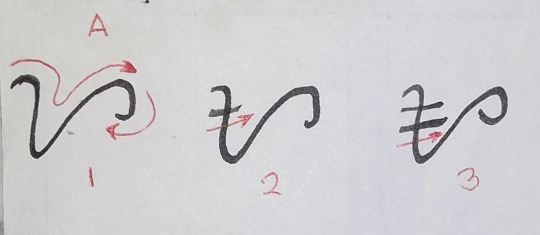
Then MA:
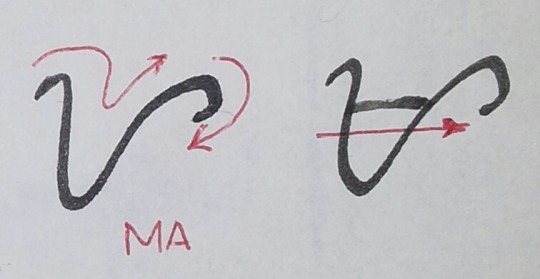
PA:
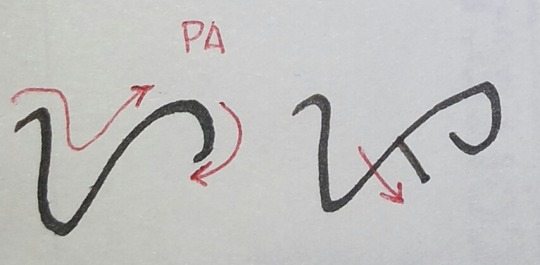
YA:
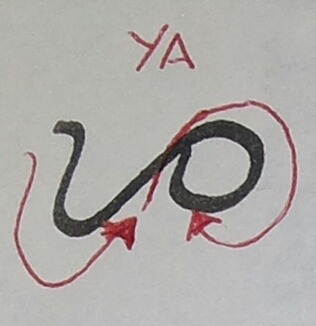
FA:
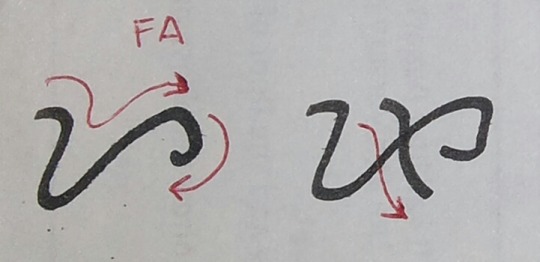
JA:
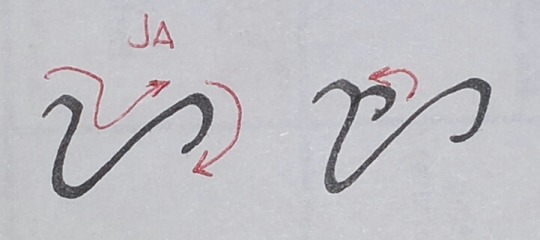
VA:
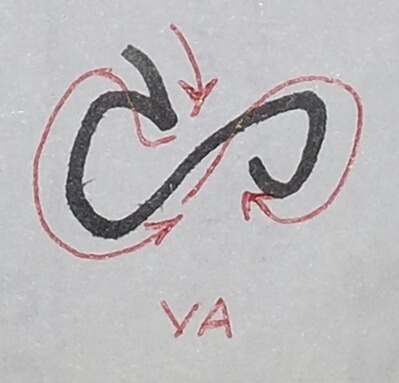
Group 2: E/I (more on that later), KA, DA, HA, RA, CA, QA, XA
I’ll start with HA because it’s a foundational stroke:
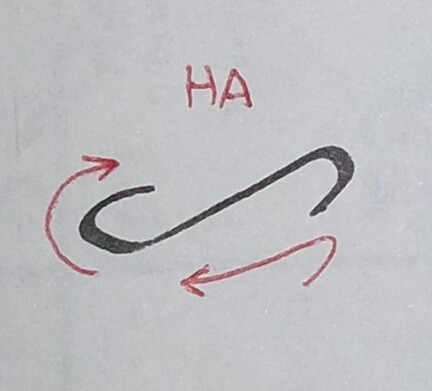
E:
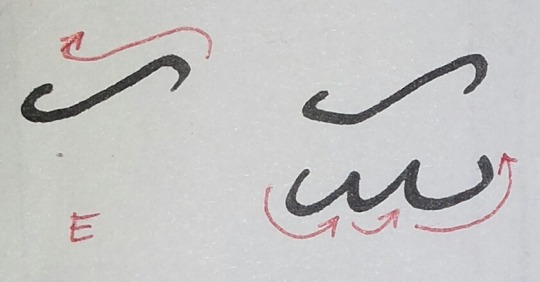
I looks structurally like E, but only with a vertical stroke on its hat.

It’s because originally, E and I were the same character and whether it should be read as a syllable from the E or I line depends on how the reader would read it and the dialect used in writing the words, like it’s a fill-in-the-blanks kind of thing. It’s also the same with O and U, so if you see that part yeah they look alike. This is also the reason why revisions on writing the E-I and O-U consonants were made, but that would be for a later part. Just be patient for now. =D
Ok, moving on, we’ll go to KA:
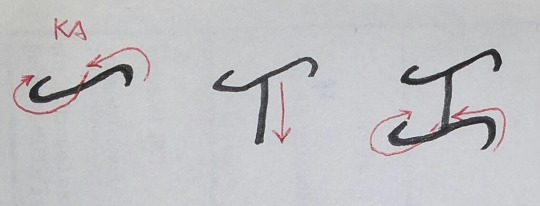
DA:
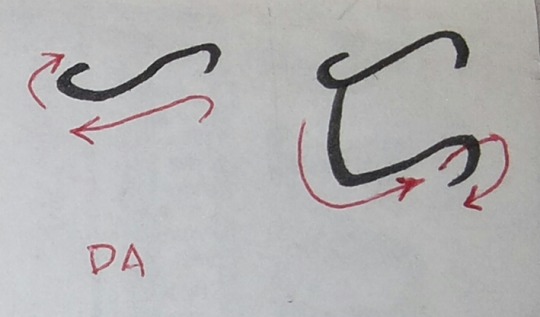
RA:

A short note on DA and RA: In olden times, these two were only one character, and are used interchangeably based on word usage, thus for words such as doon/roon, which both mean way over there one is used for passive and one is used directly (sorry not a speech comm person). This is also the case for marami and ang dami (both meaning “there are many/there is much” but one is active and one is passive. Madami is, IMHO grammatically incorrect. But then again, I’m not a speech comm person so sorry if these are wrong. I’m just saying).
CA:

QA:
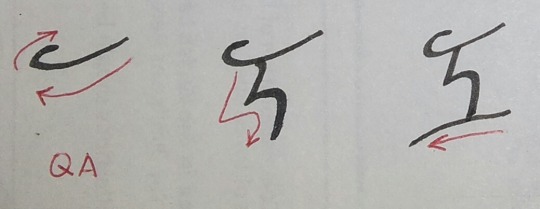
XA:

Group 3: O/U, GA, SA, ZA
Just like in E/I, O and U are also structurally similar. To make an O:
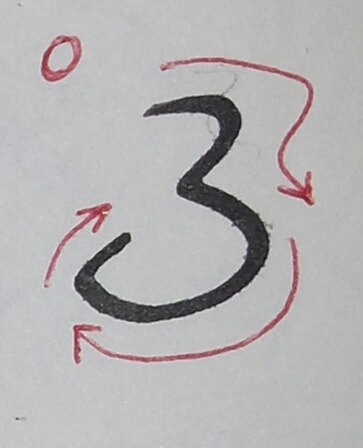
To make it a U, just put a vertical line on the right side:
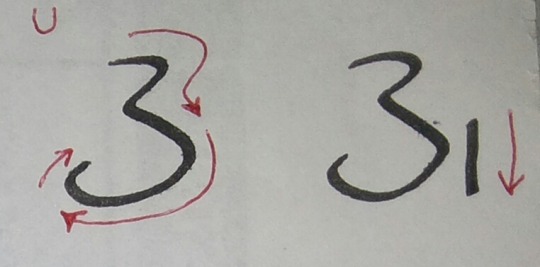
GA:
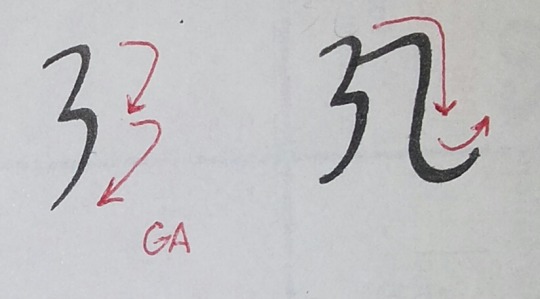
SA:
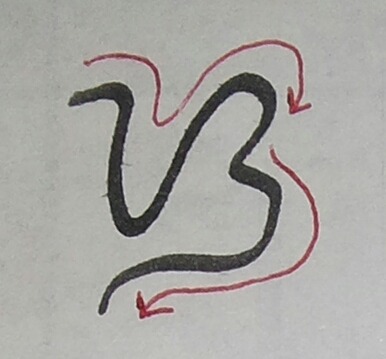
ZA:
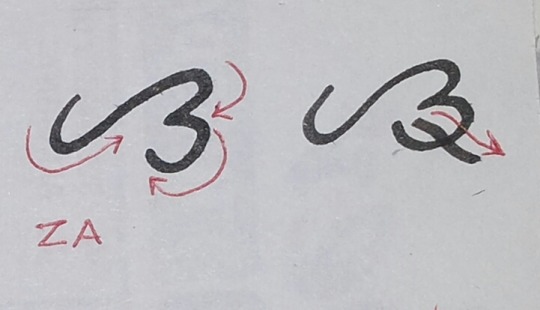
Group 4: LA, NA, TA, ÑA
I grouped this bunch based on having a downward stroke in the middle of the form. The initial strokes are written as a single stroke from left to right, like in the first group.
LA:
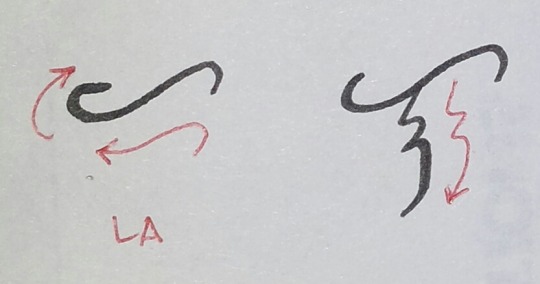
NA:
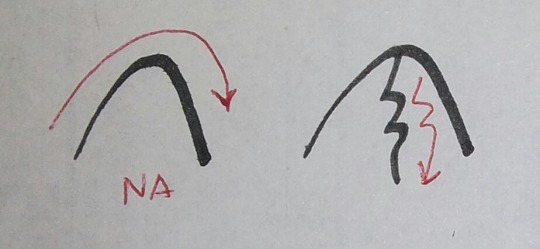
TA:
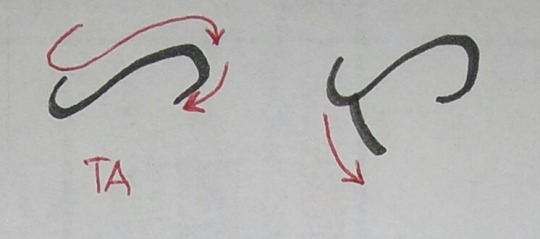
ÑA:
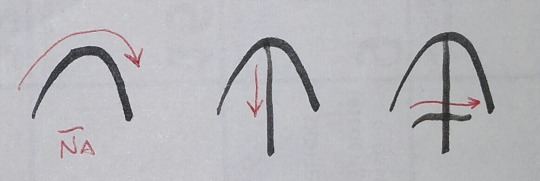
Group 5: I have no idea where to put BA, NGA, and WA so I just made a miscellaneous group lol but they deserve just as much love OK?
BA:
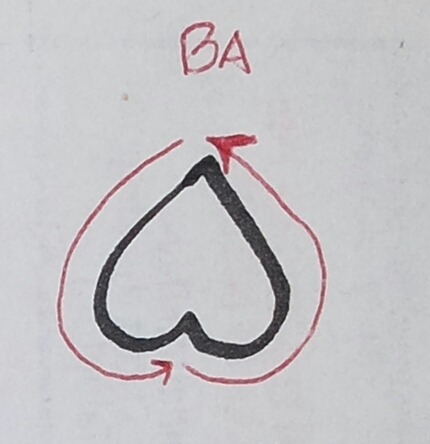
NGA:
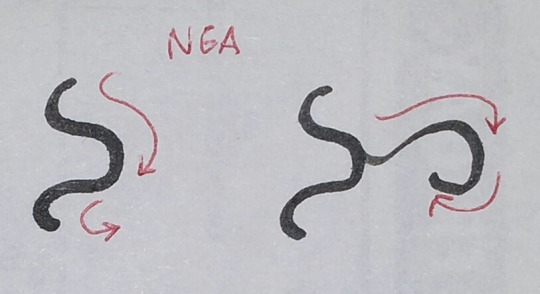
WA:
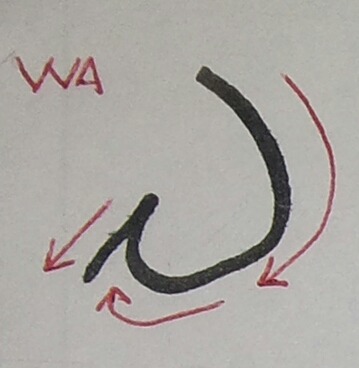
How the E, I, O and U lines are written:
In writing E, I, O and U (as in the case for the example below, which is GE, GI, GO, and GU), the original positions of the additional marks (such as the vertical lines for I and U) were kept but in order to differentiate E from I and O from U, the marks were made to be further distinct. For instance, GE is basically GA which has a horizontal line above it, while GI has a dot above it. As for GO, it has a dot below and GU has a horizontal line.

GI and GO can have either a hollowed dot like in the sample, or can also be filled like the samples below. It’s based on personal preference. Also I used G for the samples because it looks nice, fun to write, and most other examples of alibata on the internet use BA as their examples for this portion. Whoops, I meant, baybayin. XD
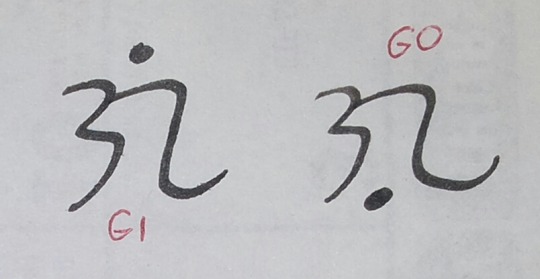
Vowel Killers: Invented by People who Needed It
I’m not entirely sure why vowel killer was the term used but it does tell it exactly what it does: it silences the vowels in the characters (because baybayin is composed of syllables) in order to make separate letters. It was invented by some Spanish friar who couldn’t properly write the native words because words that have consonants at the end were written incompletely. I.E. the word DOON (over there) was written as DO-O in baybayin. It was such a drag that he decided to introduce the Spanish/Latin alphabet by making baybayin characters that acted as alphabets, which is essentially killing all the vowels and leaving the consonant behind. So instead of using dots, the friar made a cross underneath the symbol which they called a kudlit (for obviously non-secular reasons), so that the words with consonant ends can be written and read as they were. As per the revision that was instated a few years ago, in order to make the baybayin a bit more secular, more forms of the vowel killers were made, which in my opinion look better than the original kudlit, because they look more organic with the forms.

As you can see in the pic of the letter G above, the first on the left is the original kudlit, which is shaped like a cross. The next one has an X, or sinawali (it’s literally based on the patterns of hard, woven rattan walls called sawali which look like X’s), the next one is called a kawil (sorry dunno where that came from) and the right-most one has a pamudpod (which may have come from the word “pudpod/pudpud” literally meaning grinding or repeatedly striking something on a hard surface or on a whetting stone till it disappears or becomes flat/dull, so pamudpod is the surface that makes the item pudpod like a used pencil or eraser. Do I even make sense anymore? Oh well, YOLO).
Stringing them All Together
My personal preference is using a kawil on horizontal writing (left to right) and using a pamudpod when writing vertically. I think the overall impact is better. But then again, it’s just my personal idea. Using any of the vowel killers are, like the filled or hollow dots on I and O are personal preferences, as long as there is consistency in usage.

If you can read the above and understand where the reference came from, you probably also call baybayin as alibata, and we should totally get some tea together. XDD It pretty much means “What is there, yonder?” smth idk but yeah, it sounds like that. Old and formal Filipino/Tagalog.

Langit - sky or heaven, Lupa - ground or earth, Araw - sun, and Buwan (or Bulan in Ilokano) - moon
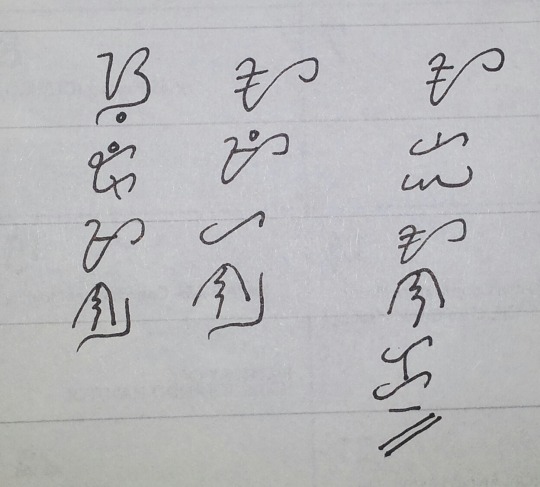
Soliman - A variant of the name Sulaiman/Solomon
Amihan - the northeast monsoon, the nice wind that brings in cool, dry air around November-March. Or if you watched the old and new Encantadia, she’s the protag. XD
The third sampler is a phrase (I ran out of space it was supposed to be a sentence), and vertical double bars are used to end the sentence. I just made them into diagonal slashes to make them look cool. Also I ran out of space. x__x It’s transliterated as a wailing mom looking for her child: Ai anaku (bunga) - Ah, my child (fruit). No space for fruit so it ain’t there.
Author’s extra rant note: Of course, some early Filipinos didn’t wanna use the kudlit due to being comfy with whatever they had at that time, but eventually they gave in. Fast forward to a century later and the baybayin was pretty much dead, as it was for the next 4 centuries or so. Romaji became the norm (except for some of the native tribes that have their own awesome writing systems), but then again some Filipinos didn’t forget it entire time, as many of the revolutionaries’ battle flags had the syllable KA, which is the first syllable of Katipunan, their group which can also be transliterated as “the entire group of the people who meet and come together”. I can’t say more because this is a long-ass post and it’s not about Philippine history. But we can talk about that if you want. Just hit me up with an ask. Warning though: I might just say “thanks for asking but please ask something else” lol j/k XDD
Writing Baybayin using a Straight-cut Calligraphy Pen/ Dip pens with Straight/Oblique Nibs
For this portion of the post, aside from posting pictures of the baybayin in black and white ink I would be pointing out that the techniques I used here are based on Western traditional calligraphy techniques used by scribes of the past, so some of the stroke patterns would be a lot different from the handwritten strokes above. But then again, if you clicked the link to get here straight away instead of reading the previous portions, well you won’t be having that much problems then. Also I will assume you already learned how to write baybayin so I’ll leave you at that. For the black baybayin, I used a calligraphy fountain pen with a 2mm straight-cut nib from the Visual Deck Set – Calligraphy box, not sure where you can buy it online but I bought mine at the National Bookstore because nobody wants to buy it. (Should’ve also bought the other calligraphy set while they’re on sale. LOL Just saying XDD). The surface is just the back of old calendars because I was just testing the strokes. For the white baybayin, I used a Speedball™ C-2 oblique-cut nib and for the ink, it’s glittery silver poster paint from Reeves™ (diluted with dH2O), and the surface is some random paper with nice surface and sizing which my father got from the office. (Apparently you can’t print anything on it so it aged well there until my father disturbed the papers’ sleep and brought them home. Now I ran out of both the calendar and the weird red paper so business is halted for a bit. XDD) Again, these are all based on how I write stuff so it’s pretty much a personal opinion, it’s not absolute but it certainly works for me so here you go.
Group 1
A:


MA:
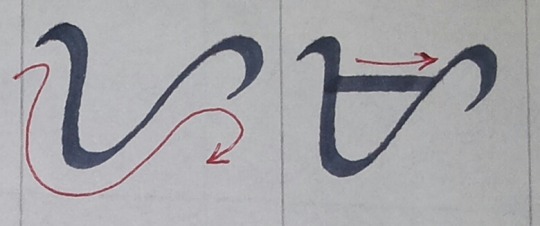
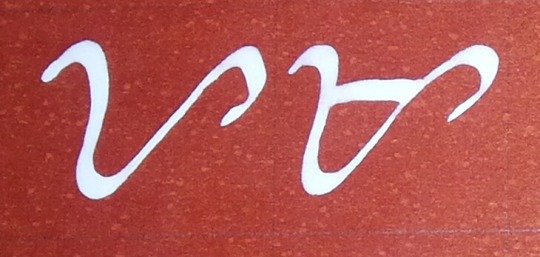
PA:
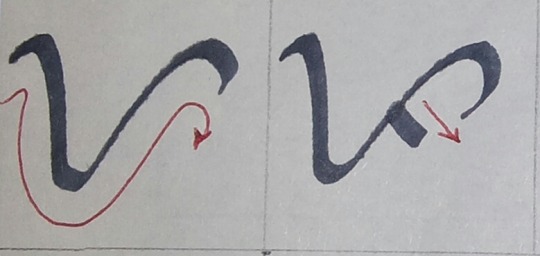

YA:
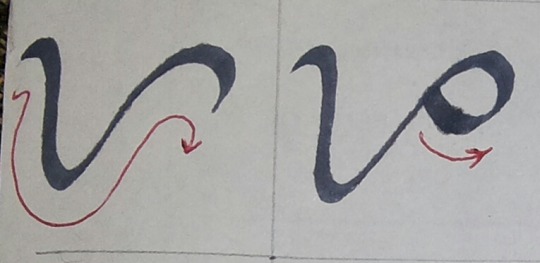
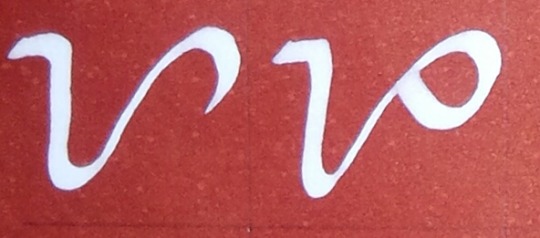
FA:
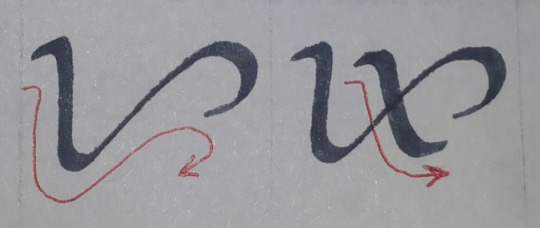
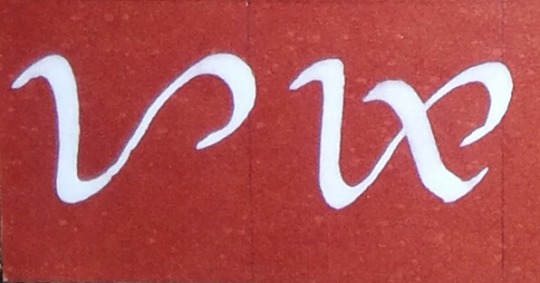
JA:
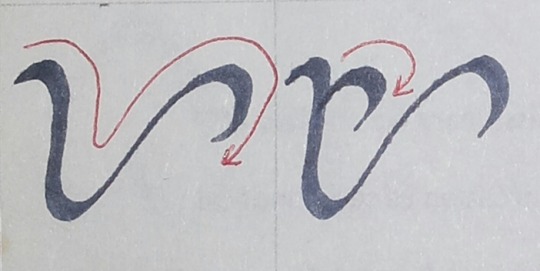
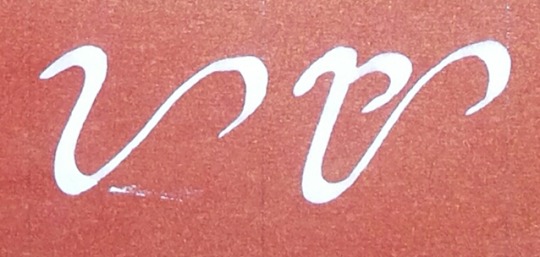
VA:
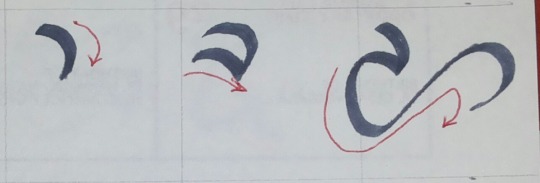
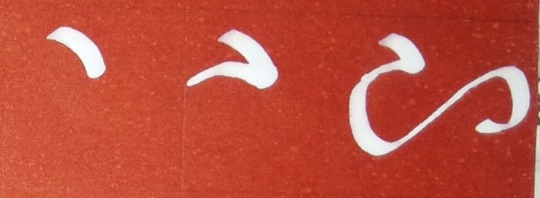
Group 2:
E/I: I’m just putting I here because E and I basically have the same strokes. To make E, just omit the final vertical stroke.


DA:
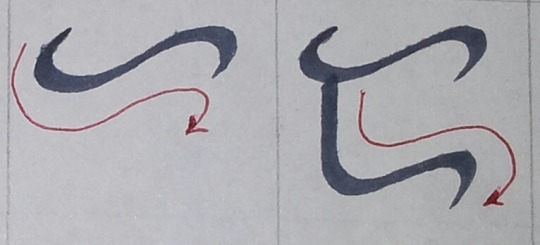

HA:
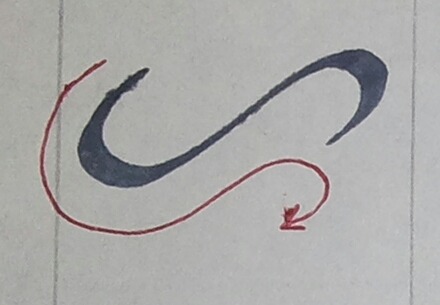
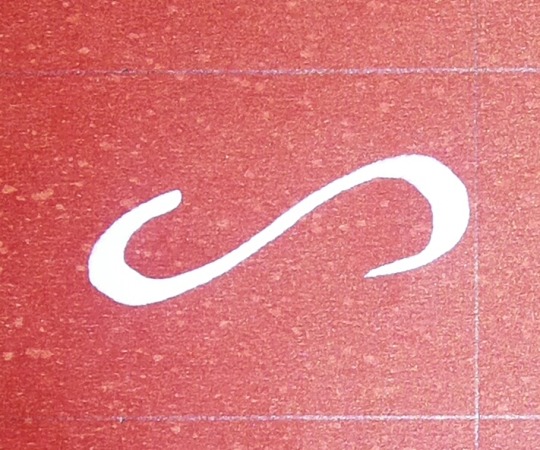
RA:
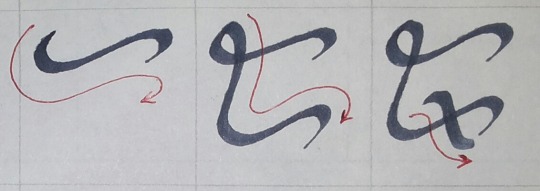
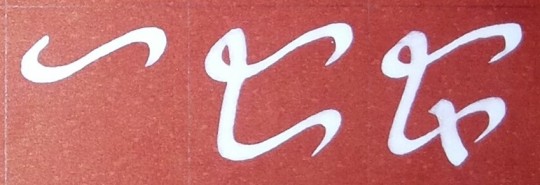
CA:


QA:


XA:


Group 3
O/U: Same with E/I, I just placed U here because O is practically the same, minus the vertical stroke on the right.


GA:
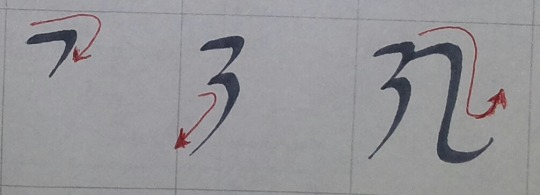

SA:
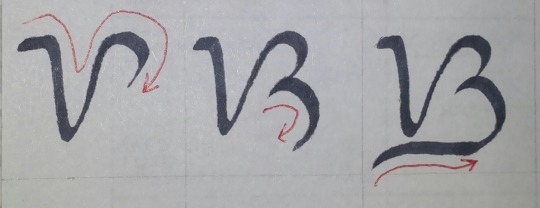

ZA:


Group 4
LA:
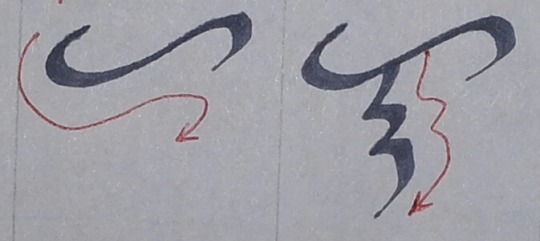
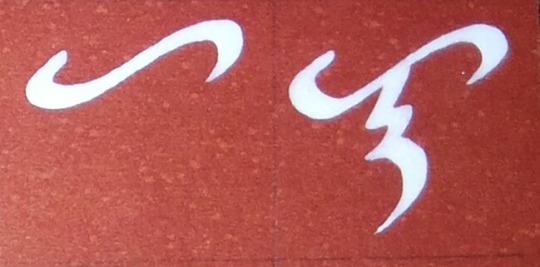
NA:


TA:
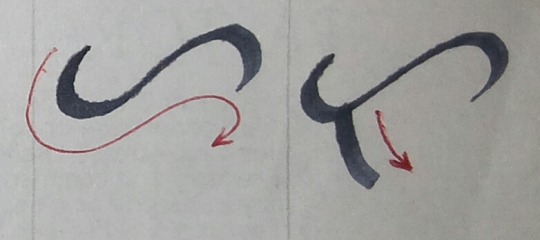

ÑA:


Group 5
BA:
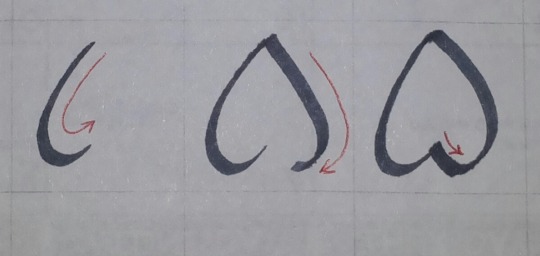

NGA:


WA:


E, I, O, U Lines


Vowel Killers

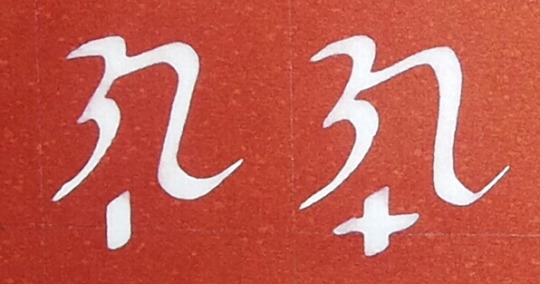
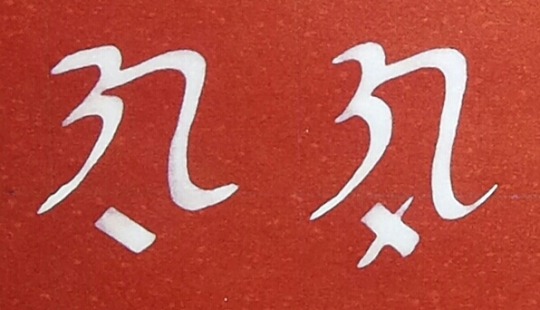
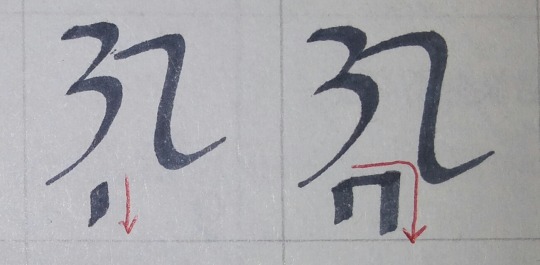
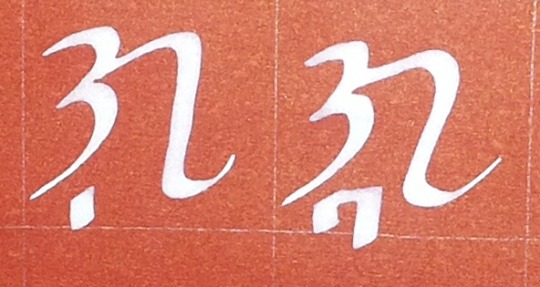
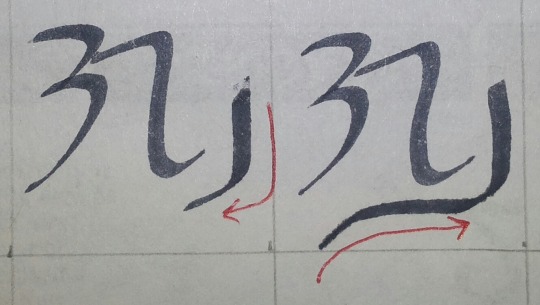
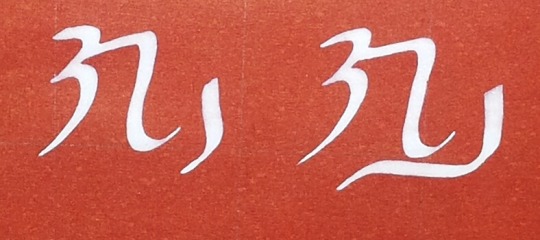
I didn’t make any full sentences or words because I ran out of nice papers, so maybe I’ll post some next time. Sorry. ._.
Author’s final note on writing using baybayin: I’m still on the fence in using the loan letters C, F, J, Ñ, Q, V, X, and Z because in my opinion apart from having redundancies with some other letters, they were just invented to spell out proper nouns that are foreign in origin. I wouldn’t even spell my full name using baybayin, except my nickname and would just rather use the Romaji/Latin Alphabet for ease. As for using baybayin to write foreign words, well, that can be as tricky as using kana to write foreign words. Both methods boil down to localizing a foreign word into how it would be pronounced based on the original language that the writing system belongs to. For instance, the Japanese waifu (as in “My waifu”) is the Japanized form of the English word “wife”, but because their spelling system is a bit different they had to estimate which kana would be suited to approximate how the word would be pronounced and in turn, be spelled. It is also the same case for some Filipino loan words that got Filipinized (and bastardized because long words are hard lol not kidding tho) such as the word istambay which originally came from “standby” and is now shortened to “tambay” which means “just loitering and doing nothing” or in how the young ones use it now: to hang out with friends (and probably just loiter and do nothing lol don’t kill me ok?). Thus, the usage of baybayin (or kana, or hangul, or Arabic because I think their writing is very lovely or whatever writing system you like that works as syllables more than letters) in writing words from another language would take extra steps such as following the rules of the written language or localizing the word first before writing them in whatever letters or syllables that you want. It’s like using what you have then making do with it/winging it out.
The End!!!! No just kidding. But it’s the last part.
To be honest there are a lot of stuff in the internet about baybayin so I’m not that entirely sure if what I have here is pretty much redundant or not. There are a lot of sites so just use your Googling skills to find what you need, although it may be a bit difficult for readers/users who simply try writing and not understanding the entire language so just use with caution. It’s hard to end up with THAT tough guy who has a kanji tattoo that actually spells “poop” instead of whatever it was supposed to be. I actually saw a guy sporting a tattoo that reads FUUBEN in Japanese, which translates to inconvenience. I lol deep inside but the guy seems happy with that so I just let him be.
Well, I hope this long-ass post helped you a lot, or at the very least the stuff made sense to you and it was worth your time reading. Please leave an ask if you have other questions, I’ll try to answer them if and when I can. Have a great day and may the force be with you. =D
#how to write baybayin#how to write alibata#how i write baybayin#baybayin handwriting#baybayin handwriting stroke order#baybayin calligraphy stroke order#baybayin calligraphy
7 notes
·
View notes
Text

#Cut Nib Calligraphy#Cut Nib Calligraphy course#certified Cut Nib Calligraphy course#Cut Nib Calligraphy writing#penkraft Cut Nib Calligraphy online course#online Cut Nib Calligraphy course#learn Cut Nib Calligraphy online#online Cut Nib Calligraphy class#Cut Nib Calligraphy materials#Cut Nib Calligraphy online for womens#Cut Nib Calligraphy online for kids#lettering and modern Cut Nib Calligraphy#lettering Cut Nib Calligraphy#Cut Nib Calligraphy lessons online#cutnip pen Cut Nib Calligraphy#Cut Nib Calligraphy classes for adults#best online Cut Nib Calligraphy course#brush lettering class#best Cut Nib Calligraphy classes#basic Cut Nib Calligraphy course#pencil Cut Nib Calligraphy
0 notes
Text
#Cut Nib Calligraphy#Cut Nib Calligraphy course#certified Cut Nib Calligraphy course#Cut Nib Calligraphy writing#penkraft Cut Nib Calligraphy online course#online Cut Nib Calligraphy course#learn Cut Nib Calligraphy online#online Cut Nib Calligraphy class#Cut Nib Calligraphy materials#Cut Nib Calligraphy online for womens#Cut Nib Calligraphy online for kids#lettering and modern Cut Nib Calligraphy#lettering Cut Nib Calligraphy#Cut Nib Calligraphy lessons online#cutnip pen Cut Nib Calligraphy#Cut Nib Calligraphy classes for adults#best online Cut Nib Calligraphy course#brush lettering class#best Cut Nib Calligraphy classes#basic Cut Nib Calligraphy course#pencil Cut Nib Calligraphy
0 notes